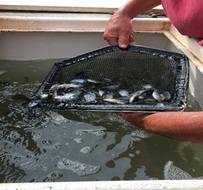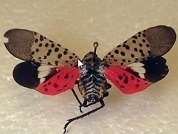|
Invasive species and the Organisms in Trade pathway in Michigan
Today’s world is more connected than ever considering the tangled web of trade routes that crisscross the globe, so it’s no wonder that many invasive species find their way here with the help of humans. Modern means of transportation bring goods, services, people and invasive species to all reaches of the globe.
 Ballast water from ships is to blame for introducing many invasive organisms to Great Lakes waters. Some exotic pets and plants that escape into the wild adapt to local conditions. Insects arriving from abroad in wood packing materials and wood products have caused irreparable damage to native trees and forests. The bottom line is that domestic and international commerce and trade can play a large role in invasive species introduction and spread.
This issue of Michigan’s Invasive Species Newsletter takes a closer look at some of the organisms and trade pathways that are important for protecting Michigan from the impacts of invasive species.
|
The internet as a pathway for invasive species
We’ve all been told to be careful about internet use to avoid computer viruses like worms or Trojan horses – but did you know that internet shopping can also introduce invasive species to Michigan? Going online to purchase plants for your yard, pond, or aquarium is a good way to find a wider selection, but sellers outside of the state may be unaware that certain species are prohibited or restricted in Michigan. Find out what you need to know about shopping online.
Invasive species laws for Organisms in Trade
Ever hear the story about pet alligators getting flushed down the toilet in New York City and surviving only to breed in the sewers? From what I hear that’s just an urban legend. But there are plenty of real-life examples of plants and animals escaping captivity - intentionally or accidentally - and wreaking havoc. Efforts to prevent exotic species from being introduced or spread are often accomplished with laws and regulations. Here’s a quick summary of Michigan and Federal laws with links to learn more.
Go Beyond Beauty: Committing to an invasive species-free landscape
In 2010, the Northwest Michigan Invasive Species Network (ISN) compiled a list of the “Top Twenty Least Wanted Species” for northwest lower Michigan, and more than half of the plants featured are invasive ornamentals that can be purchased legally. ISN’s Go Beyond Beauty program is a voluntary, grassroots effort to combat these harmful sales.
 DNR Law Enforcement efforts
The Michigan Department of Natural Resources Law Enforcement Division (LED) conducted 241 inspections on wholesale and retail bait dealers in late 2017 and early 2018. These inspections are part of LED’s efforts to address known pathways of aquatic invasive species (AIS) into the Great Lakes Ecosystems. Find out how Conservation Officers are working to prevent the spread of invasive species.
|
New invasive species training modules online
The Midwest Invasive Species Information Network (MISIN) website features 12 new online training modules on Michigan’s prohibited and restricted aquatic plant and animal species developed by the Reduce Invasive Pet and Plant Escapes (RIPPLE) program. Find out more about MISIN training modules.
 Species
Spotlight: spotted lanternfly (Lycorma
delicatula)
The
spotted lanternfly is an invasive plant hopper native to China, Vietnam, and
India. The insect was first discovered
in Berks County in southeastern Pennsylvania in 2014. If the spotted lanternfly
arrives in Michigan, it will be important to detect it as early as
possible. Learn more about the spotted lanternfly.
|
Protecting Michigan resources through quarantine
Plant pest quarantines are a tool used to protect resources
in natural and managed ecosystems from being attacked by pests and diseases. Such
quarantines may restrict the production, movement, or existence of plants and
plant products or other articles which could result in the introduction or
spread of the pest. Find out about Michigan's quarantines.
Compliance inspections for plant nurseries and sellers help
find invasive species
There are a lot of firms in Michigan that sell plants to
the gardening public and some of those plants are aquatic species. Michigan’s
nursery inspection law requires MDARD to inspect hardy nursery stock at these
firms for presence of insect pests and diseases. This 2017 overview explains how invasive plants can be difficult for consumers to identify.
Michigan's
Invasive Species Program is cooperatively implemented by the Michigan
Departments of Agriculture & Rural Development, Environmental Quality and
Natural Resources. For more information, go to www.michigan.gov/invasivespecies
|